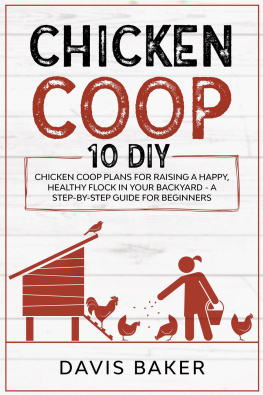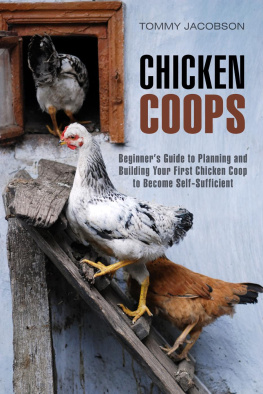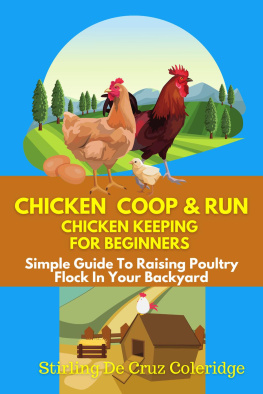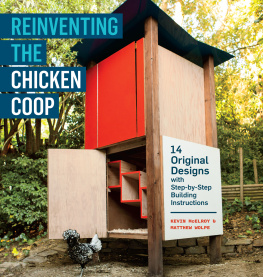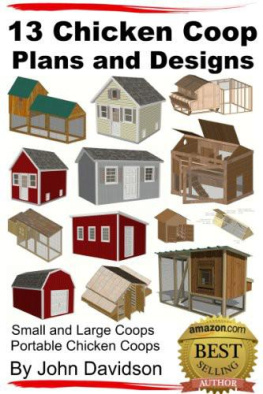Chicken Coops
Chicken Coops
45 Building Plans for Housing Your Flock
JUDY PANGMAN

The mission of Storey Publishing is to serve our customers by
publishing practical information that encourages
personal independence in harmony with the environment.
Edited by Sarah Guare and Deborah Balmuth
Art direction and text design by Cynthia McFarland and Kent Lew
Cover design by Kent Lew
Cover photographs by Getty Images: top row center; Bruce Goodson: middle row, left;
Dennis Harrison-Noonan: top row, left; Judy Pangman: top row, right; middle row, right and bottom.
Back cover illustration by Elayne Sears
Text production by Jennifer Jepson Smith
Finished coop illustrations by Elayne Sears
Plan drawings by Brigita Fuhrmann
Indexed by Andrea Chesman
2006 by Judy Pangman
All rights reserved. No part of this book may be reproduced without written permission from the publisher, except by a reviewer who may quote brief passages or reproduce illustrations in a review with appropriate credits; nor may any part of this book be reproduced, stored in a retrieval system, or transmitted in any form or by any means electronic, mechanical, photocopying, recording, or other without written permission from the publisher.
The information in this book is true and complete to the best of our knowledge. All recommendations are made without guarantee on the part of the author or Storey Publishing. The author and publisher disclaim any liability in connection with the use of this information. For additional information please contact Storey Publishing, 210 MASS MoCA Way, North Adams, MA 01247.
Storey books are available for special premium and promotional uses and for customized editions. For further information, please call 1-800-793-9396.
Printed in the United States by Versa Press
20 19 18 17 16 15 14 13 12 11 10 9
Library of Congress Cataloging-in-Publication Data
Pangman, Judy.
Chicken coops / by Judy Pangman.
p. cm.
Includes bibliographical references and index.
ISBN 978-1-58017-627-9 (pbk. : alk. paper)
ISBN 978-1-58017-631-6 (hardcover : alk. paper)
1. ChickensHousing. I. Title.
SF494.5.P36 2006
636.50831dc22
2006007688
Acknowledgments
For my parents, John and Lorraine Pangman,
and Franks mom, Elizabeth Johnson, thank you for everything.
Frank, thanks for going on that hayride twelve years ago.
For Jessie, Randy, Dana, Shannon, Greydon, and Arleigh, and grandkids
Dakota, Ethan, Mikayla, Denver, Austin, Paije, and Haylee:
For Frank and me, the farm is our dream; you are our hearts.
I could not have done this without all of you.
I would also like to thank all of the coop owners for their generous contributions:
Jana Barnhart, Karen Bassler, Herman Beck-Chenoweth, Bryan Boyer, Jennifer Carlson,
Mark and Jodi Clagg, Sharon and Ray Ely, Rena and Gary Georger, Bruce Goodson,
Loren Guernsey, Charles and Linda Gupton, Dennis Harrison-Noonan, Jim and Adele Hayes,
Trish Nickerson, Peter Poirier, Fred Rehl, Joel Salatin, Eric and Melissa Shelley,
Elizabeth Smith, Crane Stavig, Megan and Lynette Terrel, Stephanie Van Parys,
Jennifer Ward, and Eric and Pam Wettering.
PREFACE
I WAS GIVEN A FEW CHICKENS, a customer told me at the farmers market. You know how that happens you just end up with them, and then two became six, and the next thing I knew, I was a chicken farmer. I had to laugh because I do know how that happens. We started with a dozen hens a few years ago; now we have more than two hundred laying hens.
Traditionally, most small family farms raised a few chickens in the barnyard. They supplied eggs and meat for the family and neighbors, and surplus was used for barter. During the past 50 years, chicken production followed the exodus from small family farms to factory farms. In this industrial model, hens are packed tightly together in small cages to simplify feeding, watering, and egg collection. Egg production increased dramatically while the hens life became intolerable.
A growing desire to live in tune with nature and to raise safe and healthy food from humanely treated animals has sparked renewed interest in raising chickens in a natural setting. Rural and urban dwellers alike are seeking ways to connect with the land.
A new phenomenon, the urban chicken, is bringing people together across backyards in many large cities where local ordinances permit residents to raise a few chickens within city limits. As the pastured-poultry movement grows across the country, chickens are helping small family farms make a comeback. From sharing coop designs with aspiring chicken owners to supplying meat, eggs, and compost for their neighbors, chicken owners are making connections, building community, and rebuilding the small-family-farm community.
My husband, Frank Johnson, and I and our young sons Greydon and Arleigh run Sweet Tree Farm, a 200-acre grass-based livestock farm in beautiful upstate New York. We became interested in chickens when we learned about pastured poultry and discovered how healthy the hens were for our soil. Now, in addition to grass-fed beef and pork, we also produce eggs from pastured laying hens. After six years of raising laying hens, we are still learning. There are even more ways that we could improve our coops and new coop designs that we would love to build.
These pages are filled with a variety of chicken coops, including chick brooders, city chicken coops, pastured laying hen and broiler coops, and other fun and unusual coops. Some of the coops are fancy, and others are made entirely of recycled and salvaged materials. You will be introduced to city chickens and school chickens and will learn a bit about grass farms and pastured-poultry operations.
You may want to build an exact replica of a plan you see in the book, or you may want to adapt a plan to fit your own needs. In order to use the information, you will need to have basic construction knowledge. If you would like more specific building information, read How to Build Animal Housing by Carol Ekarius (Storey Publishing, 2004).
Chicken coop owners from across the country generously shared with me their designs and provided tips for using salvaged materials. The features in some of these coops have sparked new ideas (sorry, Frank!) that I would love to implement. I hope that you, too, find lots of ideas in these pages.
1
Providing Shelter: The Basics
THERE IS a lot of information out there, on the Web, in books, and in magazines, about raising chickens, and there are many ways to go about doing it. If you have never raised chickens before, all of this information may be confusing. The most important thing to know is that raising chickens is easy and should be lots of fun!
Chickens have very basic needs: food and water, adequate shelter and space, and predator protection. Chicken owners go to all different lengths to meet those needs, from the simplest to the very elaborate. The beauty of raising chickens is that there is no set formula and no way that you must do it to be successful. You can be as creative and elaborate, or as simple, as youd like. If you want to nail two old 1-inch 18-inch boards together into a little A-frame connected by a few furring strips and call it a chicken coop (see the Setting Hen Hut, ), you can. Your hen will be just as happy, and her eggs just as beautiful and yummy, as the hen down the street living in the elaborate chicken coop with the gabled roof and painted trim! Chickens can thrive in the country and in city backyards in coops of all shapes and sizes, as long as their basic needs are met.
Next page

